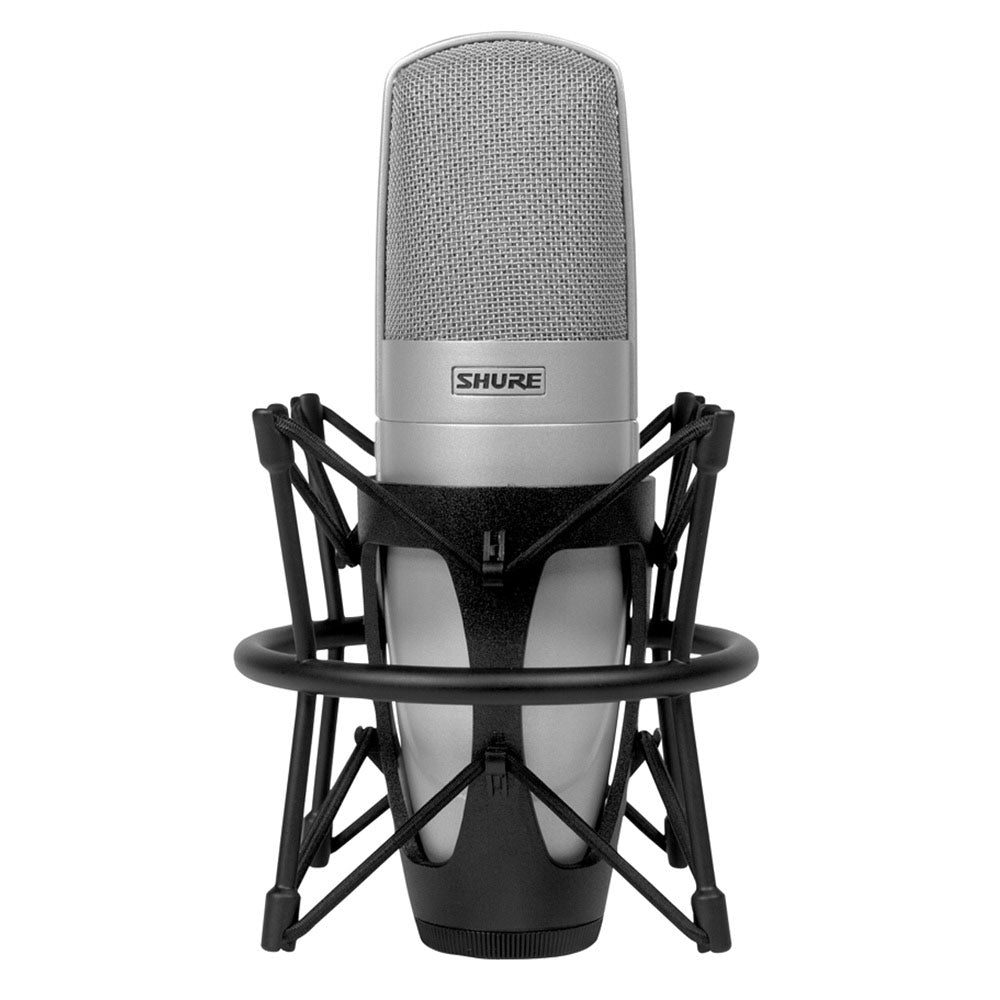
Description
The KSM32 is an embossed single-diaphragm, side-address, cardioid condenser microphone for highly critical studio recording and live sound productions. The Shure KSM32 offers an extended frequency response for an open, natural sounding reproduction of the original sound source.
Features:
- Class A, transformerless preamplifier circuitry eliminates cross-over distortion for improved linearity across the full frequency range.
- Embossed, high-compliance diaphragm provides extended low-frequency response.
- Ultra-thin, gold-layered, low-mass, Mylar® diaphragm for excellent transient response
- 15 dB attenuation switch for handling extremely high sound pressure levels (SPL)
- Switchable low-frequency filter provides greater flexibility to reduce background noise or to counteract proximity effect.
- Integrated three-stage pop protection grille reduces pop and other breath noise
- Internal shock mount reduces transmission of handling noise
Performance Characteristics
- Extended frequency response
- Very low self-noise
- Exceptional low-frequency reproduction
- High output level
- High input SPL capability
- No cross-over distortion
- Extremely uniform polar response
- Superior common mode rejection and suppression of radio frequency interference
Applications
Some typical applications for the KSM32 are listed below. Microphone use, however, is a matter of personal taste. The KSM32 may be used for a variety of applications other than those listed.
- Voice -- solo, background, voice-over, broadcasting
- Acoustic instruments -- such as piano, guitar, drums, percussion, strings
- Wind instruments -- brass and woodwind
- Low frequency instruments -- such as double bass, electric bass, kick drum
- Overhead miking -- drums or percussion
- Ensembles -- choral or orchestral
- Room ambiance pick-up -- guitar amplifier or drums
Both the acoustic environment and microphone placement have significant effects on the sound obtained when miking a source. You may need to experiment with these variables to achieve the best overall sound for each application.
| Cartridge Type | Permanently-biased Condenser |
| Frequency Response | 20 to 20,000 Hz |
| Directional Polar Pattern | Cardioid |
| Output Impedance | 150 ohms (actual) |
| Attenuation Switch | 0 or -15 dB attenuation |
| Low Frequency response switch | flat; -6 db/octave below 115 Hz;-18 dB/octave below 80 Hz |
| Phantom Power | 48 Vdc +/- 4 Vdc (IEC-268-15/DIN 45 596), positive pins 2 and 3 |
| Current Drain | 4.65 mA typical at 48 Vdc |
| Common Mode Rejection | > 50 dB, 20 Hz to 20 kHz |
| Polarity | Positive pressure on diaphragm produces positive voltage on output pin 2 relative to pin 3 |
| Dimensions and Weight | 55.9 mm (2.20 in.) maximum body diameter, 187 mm (7.37 in.) long, 490 grams (17.3 oz.) |
| Sensitivity (typical, at 1000 Hz; 1 Pa = 94 dB SPL) | -36 dBV/Pa (16 mV) |
| Self-noise (typical, equivalent SPL; A-weighted, IEC 651) | 13 dB |
| Maximum SPL at 1000 Hz | 139 (154) dB 133 (148) dB |
| Output Clipping Level | 2500 ohm load (Attenuator on): +9 dBV 1000 ohm load (Attenuator on): +3 dBV |
| Dynamic Range | 2500 ohm load: 126 dB 1000 ohm load: 119 dB |
| Signal to Noise ratio | 81 dB |
| Total Harmonic Distortion (THD), 2500 ohm load | <0.08% for a 120 dB equivalent SPL input. |
| 20 Hz to 20 kHz; THD < 1%. THD of microphone preamplifier when applied input signal is equivalent to cartridge output at specified SPL. | S/N ratio is difference between 94 dB SPL and equivalent SPL of self-noise, A-weighted. |
The KSM32 is an embossed single-diaphragm, side-address, cardioid condenser microphone for highly critical studio recording and live sound productions. The Shure KSM32 offers an extended frequency response for an open, natural sounding reproduction of the original sound source.
Features:
- Class A, transformerless preamplifier circuitry eliminates cross-over distortion for improved linearity across the full frequency range.
- Embossed, high-compliance diaphragm provides extended low-frequency response.
- Ultra-thin, gold-layered, low-mass, Mylar® diaphragm for excellent transient response
- 15 dB attenuation switch for handling extremely high sound pressure levels (SPL)
- Switchable low-frequency filter provides greater flexibility to reduce background noise or to counteract proximity effect.
- Integrated three-stage pop protection grille reduces pop and other breath noise
- Internal shock mount reduces transmission of handling noise
Performance Characteristics
- Extended frequency response
- Very low self-noise
- Exceptional low-frequency reproduction
- High output level
- High input SPL capability
- No cross-over distortion
- Extremely uniform polar response
- Superior common mode rejection and suppression of radio frequency interference
Applications
Some typical applications for the KSM32 are listed below. Microphone use, however, is a matter of personal taste. The KSM32 may be used for a variety of applications other than those listed.
- Voice -- solo, background, voice-over, broadcasting
- Acoustic instruments -- such as piano, guitar, drums, percussion, strings
- Wind instruments -- brass and woodwind
- Low frequency instruments -- such as double bass, electric bass, kick drum
- Overhead miking -- drums or percussion
- Ensembles -- choral or orchestral
- Room ambiance pick-up -- guitar amplifier or drums
Both the acoustic environment and microphone placement have significant effects on the sound obtained when miking a source. You may need to experiment with these variables to achieve the best overall sound for each application.
| Cartridge Type | Permanently-biased Condenser |
| Frequency Response | 20 to 20,000 Hz |
| Directional Polar Pattern | Cardioid |
| Output Impedance | 150 ohms (actual) |
| Attenuation Switch | 0 or -15 dB attenuation |
| Low Frequency response switch | flat; -6 db/octave below 115 Hz;-18 dB/octave below 80 Hz |
| Phantom Power | 48 Vdc +/- 4 Vdc (IEC-268-15/DIN 45 596), positive pins 2 and 3 |
| Current Drain | 4.65 mA typical at 48 Vdc |
| Common Mode Rejection | > 50 dB, 20 Hz to 20 kHz |
| Polarity | Positive pressure on diaphragm produces positive voltage on output pin 2 relative to pin 3 |
| Dimensions and Weight | 55.9 mm (2.20 in.) maximum body diameter, 187 mm (7.37 in.) long, 490 grams (17.3 oz.) |
| Sensitivity (typical, at 1000 Hz; 1 Pa = 94 dB SPL) | -36 dBV/Pa (16 mV) |
| Self-noise (typical, equivalent SPL; A-weighted, IEC 651) | 13 dB |
| Maximum SPL at 1000 Hz | 139 (154) dB 133 (148) dB |
| Output Clipping Level | 2500 ohm load (Attenuator on): +9 dBV 1000 ohm load (Attenuator on): +3 dBV |
| Dynamic Range | 2500 ohm load: 126 dB 1000 ohm load: 119 dB |
| Signal to Noise ratio | 81 dB |
| Total Harmonic Distortion (THD), 2500 ohm load | <0.08% for a 120 dB equivalent SPL input. |
| 20 Hz to 20 kHz; THD < 1%. THD of microphone preamplifier when applied input signal is equivalent to cartridge output at specified SPL. | S/N ratio is difference between 94 dB SPL and equivalent SPL of self-noise, A-weighted. |
Your home for all things pro audio—backed by expertise and experience. Connect with us today.
Your home for all things pro audio—backed by expertise and experience. Connect with us today.


